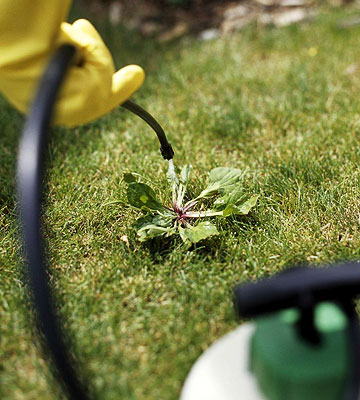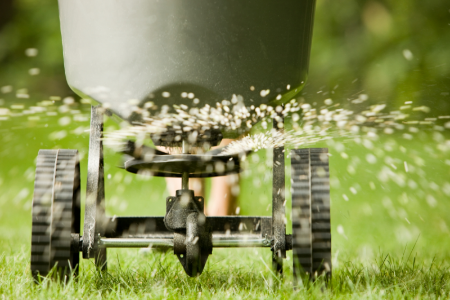
Happy New Year, it’s hard to believe that 2017 is already upon us! The start of a new year is a great time to establish a vision and plan for your Gastonia, NC lawn.
Take a moment to think about your lawn. What changes do you want to see in your turf in 2017? Set your expectations depending on the starting condition of your lawn. If your lawn is ridden with weeds, bare spots, or other eyesores, it could take an entire growing season before you see the change you’re hoping for. Late winter (late February/early March) is the perfect time to get started: spring clean-ups, first round of lawn treatments, trimming, and pruning.
Lawn care and landscaping is all about timing. When it comes to your lawn, there’s no such thing as fashionably late. Get the most out of your efforts by giving your lawn what it needs, when it needs it. We landscapers instinctively know there is a right time for everything we do from fertilizing to treating diseases and pests to planting perennials. If we choose to ignore the cycles of Mother Nature, we know it will be harder to achieve the results we want.
TREATING BROADLEAF WEEDS

Broadleaf weeds are the worst nuisance of fescue lawn lovers. Chickweed, henbit, clover, dandelions, and others invade quickly and spread relentlessly during February and March, as the ground begins to warm.
The right time: Treat young, actively growing weeds early and often.
Why timing matters: Used properly, liquid broadleaf weed killers are highly effective, but may fail when conditions aren’t optimal. Temperature is an important factor for post-emergence herbicide application.
In cooler temperatures of late fall and winter (45 to 60 degrees F), treat the weeds with an ester (oil based) broadleaf selective herbicide. It will take longer to kill the weeds, but this formulation works in cooler weather. In warmer temperatures of late spring and early summer (60 to 85 degrees F), treat the weeds with an amine salt (water based) broadleaf selective herbicide with surfactant added. When temperatures rise above 85 degrees, turf grasses experience stress, and applying chemicals such as herbicides or fertilizers will amplify the stress and cause damage.
In addition to temperature, other timing that creates ideal conditions for the most effective absorption are no rainfall for 24 hours, and applying herbicide 2 days before or 2 days after the mowing.
USING WEED PREVENTERS
 Pre-emergent herbicides, often sold as crabgrass preventers, are effective for controlling summer annual grassy weeds such as crabgrass and goosegrass. Pre-emergents establish a chemical barrier that will not kill established plants, but will prevent weeds from successfully growing. However, they do not control perennial weeds such as dallisgrass, dollarweed, or bahiagrass. A pre-emergent herbicide treatment lasts for approximately 6 weeks. A split dose application is ideal where 50% of the active ingredient is applied in late February and repeated in early April. This provides a 12 week protection period during the most active germination time.
Pre-emergent herbicides, often sold as crabgrass preventers, are effective for controlling summer annual grassy weeds such as crabgrass and goosegrass. Pre-emergents establish a chemical barrier that will not kill established plants, but will prevent weeds from successfully growing. However, they do not control perennial weeds such as dallisgrass, dollarweed, or bahiagrass. A pre-emergent herbicide treatment lasts for approximately 6 weeks. A split dose application is ideal where 50% of the active ingredient is applied in late February and repeated in early April. This provides a 12 week protection period during the most active germination time.
The right time: Apply pre-emergent when the temperature in the top one inch of soil has been 55 degrees F for three consecutive days.
Why timing matters: Weed preventers are not effective against winter weeds that have already begun to grow, so you must apply them before germination to gain any benefit. Crabgrass, the primary goal of lawn weed preventers, normally germinates as the ground warms, so take your cue from Mother Nature. For our Gastonia, NC lawns that is typically around the last week of February to first week of March.
Need to reseed? For cool-season grasses such as fescue, fall is the ideal time. But remember: should you choose to seed in the spring, don’t apply crabgrass preventer at the same time that you plant seed; the chemical barrier stops seedlings from growing.
OVERSEEDING AN EXISTING LAWN

You may want to overseed if your lawn has bare spots, thin or patchy grass, or if the grass suffered drought or disease damage over the summer. If you don’t fill in the gaps, weeds will auto-fill for you in late winter and early spring.
The right time: for Gastonia, North Carolina, the ideal time for fescue lawns to be overseeded is early Fall (mid-September to very early October). Seeding in the spring (March) is generally not satisfactory since young seedlings do not have enough time to develop a root system capable of providing needed moisture before hot, dry summer weather arrives. If you must seed in the spring, you will need to be able to adequately water the lawn throughout the summer months into fall.
Why timing matters: Overseeding fescue grass begins to respond to the cooler temperatures of September and early October. Warm soil and moderate air temperatures encourage seed germination and there is less competition from weeds. The seeds will get two or three months to become better established before dropping temperatures stop their root growth. The new grass will have the remainder of the fall and the following spring to establish before it must survive the heat and drought stresses of summer.
A common mistake is waiting too late in the fall to overseed. If seed is to be planted in an area where autumn leaf drop is a concern, seeding should be completed by the 3rd week of September. This gives the seed 2 weeks to germinate and an additional 4 weeks for the sprouts and tender grass blades to establish before the leaves begin to suffocate the turf in late October.
